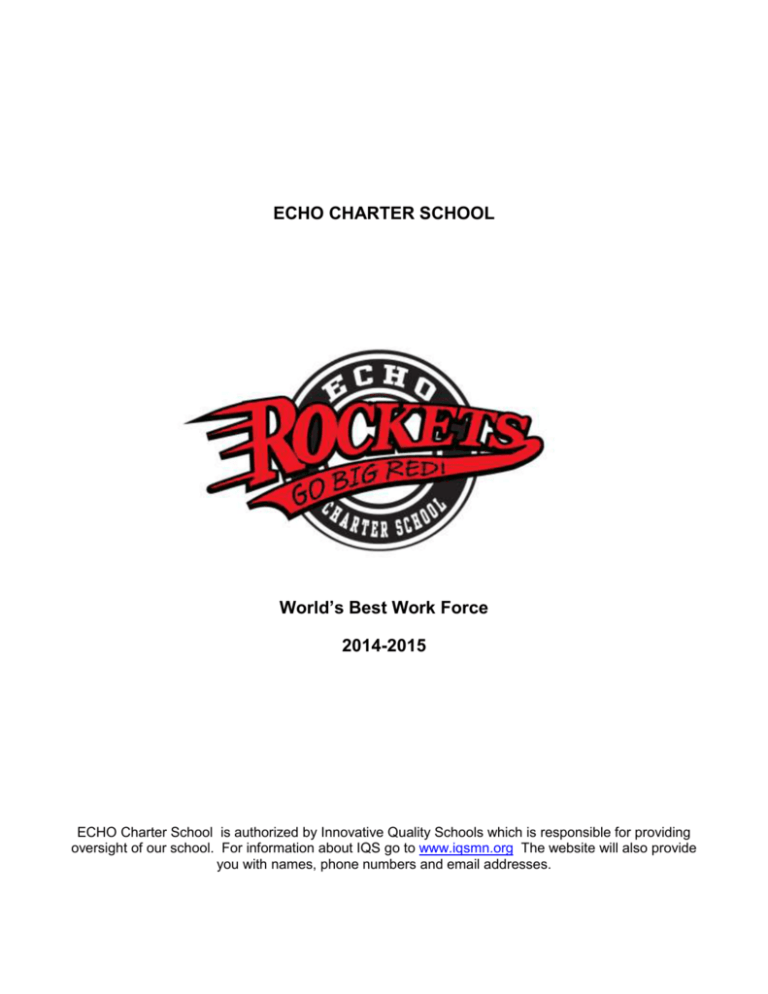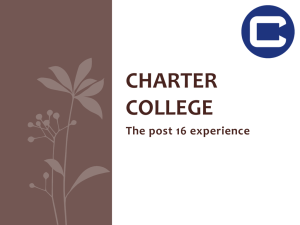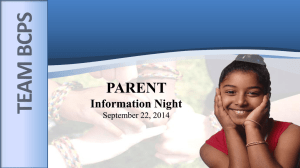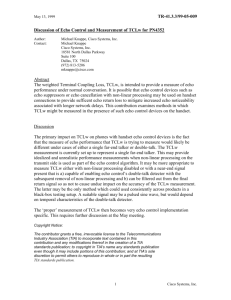2014-2015 - ECHO Charter School
advertisement

ECHO CHARTER SCHOOL World’s Best Work Force 2014-2015 ECHO Charter School is authorized by Innovative Quality Schools which is responsible for providing oversight of our school. For information about IQS go to www.iqsmn.org The website will also provide you with names, phone numbers and email addresses. World’s Best Workforce Report Summary In accordance with 2013 Minnesota Statutes, section 120B.11, the ECHO Charter School Board, at a public meeting held on February 12, 2015, adopted a comprehensive, long-term strategic plan to support and improve teaching and learning that is aligned with creating the world's best workforce. At the February 12, 2015 meeting, the school board authorized its administration to submit the following electronic summary of its annual report to the Commissioner of the Minnesota Department of Education each fall. That summary is entirely contained in this document. The report summary includes progress specifically related to: A summary of progress toward improving teaching and learning and striving for the world’s best workforce (specifically, progress toward closing the achievement gap); All students ready for kindergarten; All students in third grade achieving grade-level literacy; All students attaining career and college readiness before graduating from high school; and All students graduating from high school. Information about best practice strategies that were implemented and that are showing evidence of impacting closing the achievement gaps and working toward creating the world’s best workforce in Minnesota. Our Vision is to be, the most highly respected school in Southwest Minnesota noted for caring, innovating and preparing students to succeed. Our Mission: ECHO Charter’s School’s Mission is to be your school of choice by preparing students to achieve to their highest potential through an innovative and uniquely flexible curriculum. Strategic Initiatives 1. Be a fiscally sound school. 2. An environment that maximizes a student’s ability to learn. 3. Programs and services are in place to maximize student development. Identified Needs Based on Data In grades K-4 AIMSweb data is used to determine what students are reading below grade level. ECHO Charters school goal is to have 80% of each grade performing at current grade level, Based on this data it was determined that eleven of students needed Title 1 support. Based on data from NWEA testing and the MCA test results it was clear that there was a deficiency in Reading proficiency. Due to this we have made our Q-Comp focus to improve reading proficiency and growth school wide. STAR Reading Enterprise Test is given to grades 2-8 at least twice a year to determine reading level for each student. Based on this information students who are reading below grade level receive intervention. Support Category Students Title 1 services are provided to students who show need in the areas of reading and math based on data. K-4 Reading groups daily for 20 minutes Mental Health referral program After School Program for grades 5-12 Core Knowledge Language Arts (CKLA) program implemented in grades K-3 and 4 and 5 as it becomes available. The CKLA program is Common Core aligned. Project Based Learning (PBL) is offered 9-12 for elective credit. Career Day to SMSU for 9-12 Teachers and Principals Implementation of Q-Comp plan Professional Learning Communities(PLC’s) met weekly for 45 minutes PLC Leader Meetings CARE Teams – Elementary and Secondary meet weekly Professional development days Professional development opportunities outside of ECHO ELA Implementation Team Data review meetings Best Practice Strategies and Action Steps Meet weekly in Professional Learning Communities (PLC) that are focused on reading strategies. Ensure that the curriculum is aligned to the Minnesota Academic Standards and vertically aligned. Provide technology for teachers and students to use. Have a high level of rigor in the curriculum Have high expectations for students Have high expectations of teachers Review state and local data continuously Emphasize Literacy in all content areas Align curriculum between early childhood and Kindergarten by implementation of Core Knowledge Language Arts program (CKLA). Provide re-teaching and interventions for students Current Student Achievement Plans Q-Comp: ECHO is in our 9th year of Q-comp. We did not participate in Q-comp during the 2012-2013 school year and did not make AYP. Staff has weekly meetings called Professional Learning Community (PLC) to discuss specific reading strategies, student work, assessments and ongoing collaboration on what is working with our students and what needs to be address. Local Literacy Plan - During the 2014-2015 school year our district will continue the Core Knowledge integrated reading program to teach reading in grades K through 3 and expand it into grades 4 and 5 as it becomes available. Included in this program are components for guided reading, read aloud, shared reading and independent reading and incorporates scientifically based reading strategies and interventions. It integrates the teaching of reading across the curriculum. To enhance the curriculum, our district has an elementary library with a variety of fiction and nonfiction reading materials, covering a wide range of reading levels. Each classroom also has their own reading center where students can enjoy books and other resources selected by their classroom teacher. All K-3 students receive classroom reading instruction for a minimum of 90 minutes each day. Relevant technology engages students in meaningful learning activities. The district also uses Accelerated Reader (AR), which is a computerized program that tests basic reading comprehension. Students select books from their reading level, read independently and take an independent comprehension test on the computer. Each book is worth a given number of points based on its length and reading level. All students in grades K-3 are given the AIMSweb screening/benchmarking assessment three times throughout the course of the year in fall, winter, and spring. Using this data, along with data from the MCA's, NWEA Measures of Academic Progress, STAR tests, and curriculum imbedded assessments, struggling and at-risk students are identified and referred for interventions. Specific interventions are based on further assessments, and the interventions are implemented through the collaborative efforts of the classroom teacher and other specialists. Each student’s progress is monitored either weekly or biweekly and if the intervention selected is not working, another intervention is selected and implemented. Students not responding to these interventions are referred for special education services. Parents are kept informed of their child’s progress at every step of the process. The goal of ECHO Charter School is to ensure that all learners successfully achieve the Minnesota K-12 Academic Standards in English Language Arts (2010) for their grade level. The standards are aligned with the district’s curriculum and a map is in place to ensure that the standards are taught within the time available. Title I – ECHO Charter School spends 100% of the District’s Federal Title I funding to provide focused support called “interventions” for K-6 identified students in reading and math. During the fall, all K-6th grade students are given an assessment called AIMSweb. Aimsweb data, along with teacher observation is then used to determine what student’s needs interventions. Math interventions are provided to those students who show need based on teacher observations. Title II- ECHO Charter School spends 100% of the District’s Federal Title II funding to provide professional development and support to teachers. School Improvement: The School Improvement Plan contains the 2014-2015 Q-Comp Goals for reading, one at each school level. The plan also includes the 2014-2015 math goals, one at each school level and two operational goals for ECHO. The plan also contains seven focus areas. The seven focus areas are program implementation, test administration, data analysis, meeting individual student needs, professional development, culture of achievement and parent involvement. These seven focus areas have a chart with five headings that need to be filled in. The headings are action strategies, driver, timeline, evidence and status. This plan is updated annually and presented to the staff and board. 21st Century Out of School Time Programming: ECHO Charter School is in the first year of a three to five year 21st Century grant. We are part of a three school cohort overseen by PACT For Families. As part of this grant we are offering 420 hours of programming each year of after school and summer programming for youth in grades 5 to 12. The goals of this grant are to increase participants’ opportunities to develop and apply 21st Century skills, to increase school and community connectedness, and to increase the academic performance of participating students who are low performing or at high risk of failure in core academic classes. We also seek to incorporate opportunities for students to give input and develop responsibility, explore skills and interests, and develop social skills and positive character traits. Key Indicators of Implementation Progress AIMSweb testing NWEA – MAP Assessments EXPLORE, PLAN and ACT results STAR Reading Enterprise Test Monitor Daily Attendance Credit checks with Director MCA results Monitor student turn over Broad Outcomes Impacted All Students Ready for Kindergarten 80% of ECHO Charter School preschool students will be ready for Kindergarten in the fall of 2014 as assessed and observed by the teacher. The results were 66% of in incoming Kindergarten students were ready for Preschool in the fall of 2014. (Based on 4 students) All Students in Third Grade Achieving Grade-Level Literacy 80% of ECHO Charter School third graders entering in the fall of 2014 will be reading at grade level. The results were 60% of incoming third graders were reading at grade level in the fall of 2014, based on the STAR report. (Based on 5 students) Closing Achievement Gap(s) ECHO Charter School will decrease the proficiency gap between free and reduced and non-free and reduced, by increasing the free and reduced students’ proficiency on the MCA math and reading test by 3%. Math Reading All Students Career- and College-Ready by Graduation District was to apply for Project Based Learning (PBL). This goal was accomplished and we were granted PBL for the 2014-2015 school year. We plan to apply again for the 2015-2016 school year. 100% of 11th grade students will take the ACT Plus writing on-site beginning in the spring of 2015. 100% of 8th grade students will take the EXPLORE assessment. This goal was accomplished. 100% of 10th grade students will take the PLAN assessment. This goal was accomplished. All Students Graduate 85% of ECHO Charter School seniors graduated in 2013. Our goal is to increase that by 5% for the 2014 graduation class. The 2014 graduation rate was 100%. We would like to maintain 100% graduation rate. Q Comp Goals for 2014-15 1) Elementary Reading: The percentage of all students in grades 3-4 at ECHO Elementary School who meet or exceed their fall to spring individual RIT Growth Projection on the NWEA MAP in reading will increase from 68.8% in spring 2014 to 71.8% in spring 2015. 2) Middle School Reading: The percentage of all students in grades 5-8 at ECHO Charter School who meet or exceed their fall to spring individual RIT Growth Projection on the NWEA MAP in reading will increase from 74.2% in spring 2014 to 76.2 % in spring 2015. 3) High School Reading: The percentage of students in grades 9-10 at ECHO Charter School who meet or exceed their fall to spring individual RIT Growth Projection on the NWEA MAP in reading will increase from 68.8% in spring 2014 to 71.8% in spring 2015. 2014-15 Math Goals Elementary: The percentage of students in grades 3-4 who meet or exceed their rit target growth on the spring NWEA MAP will increase from 68.8% to 72.8% Middle School: The percentage of students in grades 5-8 who meet or exceed their rit target growth on the spring NWEA MAP will increase from 65.7% to 69.7%. High School: The percentage of students in grades 9 and 10 who meet or exceed their rit target growth on the spring NWEA MAP will increase from 56.3% to 60.3%. Operational Goals 2014-15 1) Continue to lay the foundation for Project Based Learning. 2) Expand and improve the RTI system to support the school literacy plan by expanding the RTI system to include the middle school.








